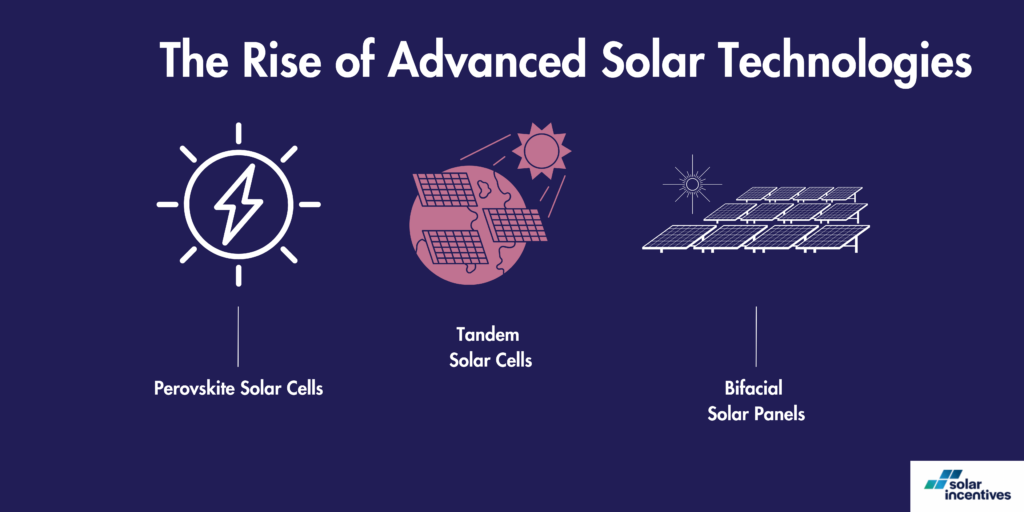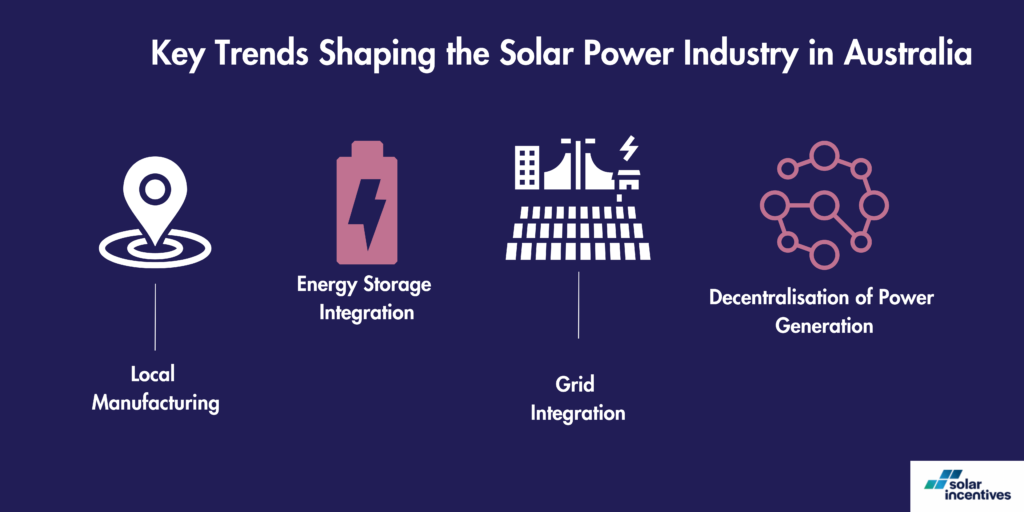Australia’s Emerging Solar Technologies and Trends in 2024

Steve Hill
Expert in Residential and Commercial Solar Solutions and Energy Efficiency
4 min read · 31st January 2024
Australia stands at the forefront of global solar energy adoption, heralding a new era of renewable energy. As of 2024, the country’s journey towards embracing solar power has been marked by significant milestones. It’s becoming a beacon in the global shift towards sustainable energy sources.
Australia’s Position in Global Solar Energy Adoption
Australia’s solar energy story is one of remarkable success and innovation. With its abundant sunshine and supportive policies, the nation has become a key player in the global solar market.
In recent years, Australia has seen a substantial increase in both residential and commercial solar installations. It outpacing many other countries in per capita solar adoption. This impressive growth is a testament to the country’s commitment to reducing greenhouse gas emissions.

Solar Energy Potential and Growth in Australia
The potential for solar energy in Australia is vast, thanks to the country’s geographical advantage. Australia’s natural abundance makes solar energy more accessible to a wider range of consumers.
The growth trajectory of solar power in Australia has been nothing short of exponential. Reports have indicated a steady rise in solar capacity. Commercial rooftop installations surpassing residential installations for the first time in recent years. This shift highlights the broadening appeal of solar energy across different sectors.
As we step into 2024, Australia’s commitment to solar energy is more evident than ever. The country is on track to achieve ambitious renewable energy targets, with solar power playing a pivotal role. This commitment is not only reflected in the expanding solar infrastructure. It is also in the innovative technologies and practices being adopted nationwide.
The Rise of Advanced Solar Technologies

The solar industry in Australia is undergoing a transformative phase. Let’s explore three of these groundbreaking technologies:
Perovskite Solar Cells: Low-cost, High-efficiency Alternatives
Innovation and Efficiency
Perovskite solar cells have emerged as a revolutionary technology in the solar industry. Characterised by their unique crystal structure. Perovskites have shown exceptional performance in laboratory settings. Boasting high energy conversion efficiencies.
Cost and Manufacturing Advantages
One of the most significant advantages of perovskite solar cells is their low production cost compared to traditional silicon cells. They are less labour-intensive to manufacture, making them a viable option for large-scale production.
Commercial Viability
While still in the developmental phase, perovskite solar cells are poised to become a commercially viable option. Research and advancements are focused on enhancing their durability and stability to match the longevity of traditional solar panels.
Tandem Solar Cells: Enhanced Output Through Advanced Absorption Properties
Dual-Layer Efficiency
Tandem solar cells represent a leap in solar technology efficiency. These cells combine multiple layers of solar cell materials, each designed to absorb different parts of the sunlight spectrum. This multi-layered approach significantly boosts the overall efficiency of the solar panels.
Technological Synergy
By stacking different photovoltaic materials, tandem cells can surpass the efficiency limitations of single-junction solar cells. They are effective in harnessing a broader spectrum of sunlight, leading to higher energy generation rates.
Future Prospects
The ongoing development in tandem solar cell technology promises to further elevate the efficiency and effectiveness of solar power systems. It’s making them more attractive for both residential and commercial applications.
Bifacial Solar Panels: Dual-sided Sunlight Capture for Optimal Energy Generation
Double-sided Design
Bifacial solar panels are designed to capture sunlight from both sides. This design allows them to absorb direct sunlight on the front side and reflect light on the backside.
Versatility in Installation
These panels are particularly beneficial in installations where reflected light can be harnessed effectively. Their ability to generate more power in a given space makes them ideal for space-constrained installations.
Key Trends Shaping the Solar Power Industry in Australia

Local Manufacturing and Its Benefits
The trend towards local manufacturing of solar panels and related technologies is gaining significant traction in Australia.
This movement is driven by a desire to reduce reliance on imports and the associated costs and vulnerabilities.
Local manufacturing is proving beneficial for the Australian economy, creating jobs, and boosting the domestic market.
Energy Storage Integration: Addressing Intermittency Issues
Integrating energy storage systems, such as batteries, is crucial in addressing the intermittency of solar power.
This allows for the storage of excess energy generated during peak sunlight hours, making solar power a more consistent and dependable energy source.
Additionally, energy storage plays a vital role in stabilising the grid, helping to manage load and reduce the strain during peak times.
Grid Integration: Balancing Solar Power Supply and Demand
The integration of solar power into the grid involves smart grid technologies that manage the inflow and outflow of solar energy. This process is ensuring a balance between supply and demand.
Policies like net metering allow solar system owners to feed excess energy back into the grid, contributing to the overall energy mix and providing financial benefits.
Effective grid integration is essential for maintaining a stable and efficient power supply, even as the proportion of solar energy in the grid increases.
Decentralisation of Power Generation: The Shift Towards Self-sufficiency
Decentralisation is where consumers generate their own electricity using solar systems. It is empowering consumers and reducing reliance on traditional grids. This self-generated power leads to energy independence and can reduce electricity bills. It also results in a more resilient energy system, less vulnerable to centralised power disruptions.
Community solar projects are a key part of this trend. This is where groups of people share the benefits of a single solar installation. It’s beneficial for those without suitable roofs for individual systems.
Government Policies and Market Dynamics

Government support and incentives have played a pivotal role in promoting solar energy in Australia.
The government’s initiatives, such as financial incentives and rebate programs, have lowered the barrier to solar adoption for both individuals and businesses.
These incentives not only make solar installations more affordable. But also show the government’s commitment to renewable energy and reducing greenhouse gas emissions.
The introduction of policies like feed-in tariffs has provided an additional financial incentive for solar system owners. Making solar energy a more attractive investment.
Electricity price trends have also had a notable impact on solar adoption in Australia. With the rising costs of traditional electricity due to various factors including global energy price volatility and network maintenance costs, solar energy has become an increasingly cost-effective alternative.
This has encouraged both residential and commercial users to turn to solar solutions as a way to stabilise their energy costs and reduce dependence on grid-supplied electricity.
Future Outlook
The future for solar energy in Australia looks bright and is expected to keep growing and improving. More and more people are installing solar panels on their roofs because they’re becoming cheaper and the government is supporting the move.
This is happening in both homes and businesses all over the country.
There’s also a big increase in larger solar projects like solar farms. These big projects are important for making more renewable energy in Australia and meeting the increasing need for clean energy. This shows Australia’s commitment to using more sustainable energy sources.
Plus, solar energy is being combined with other green technologies, like batteries and electric cars. This combination is making solar energy even more useful and environmentally friendly. The mix of these technologies is making solar energy more appealing and practical.
The Role of Consumers and Businesses
Solar technology is making a big difference in both homes and businesses across Australia. Homeowners are finding that solar panels help them save on electricity bills and can even increase the value of their homes.
For businesses, using solar energy means lower operating costs and a boost in their reputation for being eco-friendly, which is becoming more important in the market. Also, more people are getting jobs in the solar industry, which helps the economy grow.
Environmentally, using more solar energy is great for reducing carbon emissions, which helps Australia reach its environmental goals. This move towards renewable energy like solar is essential in fighting climate change and is key to a sustainable future.
Conclusion
In 2024, Australia’s solar energy sector is growing rapidly and becoming more innovative, thanks to strong support from government policies and advancements in technology.
These factors have made solar energy a major part of Australia’s energy sources. Looking ahead, it’s important for everyone – from individuals to businesses and government bodies – to keep supporting and using solar energy.
This is not only good for reducing energy costs and being more independent in terms of energy, but it’s also crucial for a more sustainable and environmentally friendly future. The push for Australians to use more solar energy is really strong, as it’s a key way to make the world cleaner and more sustainable.
If you’re considering solar energy for your home or business, it’s crucial to partner with a trusted and reliable provider. At Solar Incentives, we are committed to helping you find the right solar solutions.
Our goal is to help you significantly reduce your electricity bills and enhance your energy security for years to come.
Don’t miss out on the latest opportunities. Check out Solar Program for the most up-to-date information on government incentives. Find out how they can benefit your transition to renewable energy. Let’s make this journey together.
Article By
Steve Hill
Steve Hill has a rich background in the solar energy sector and is dedicated to empowering consumers with knowledge, particularly in residential and commercial solar solutions, solar batteries, and energy efficiency products.
Steve enjoys sharing his wealth of experience, offering practical advice, and learning about the latest trends and innovative solutions in the world of solar energy.

